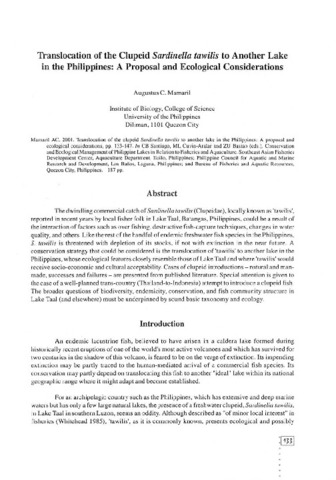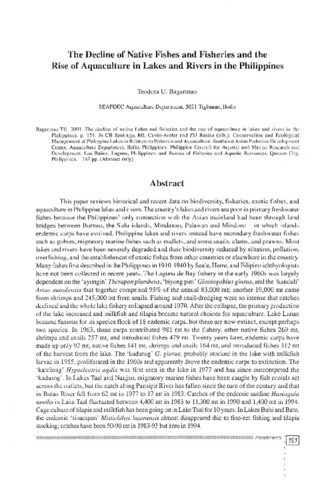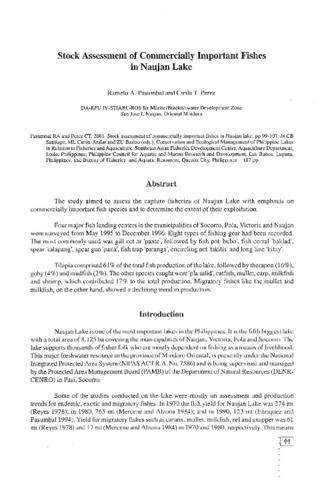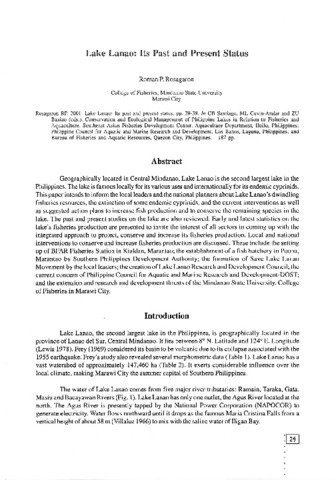Translocation of the clupeid Sardinella tawilis to another lake in the Philippines: A proposal and ecological considerations
Share
Abstract
The dwindling commercial catch of Sardinella tawilis (Clupeidae), locally known as 'tawilis', reported in recent years by local fisher folk in Lake Taal, Batangas, Philippines, could be a result of the interaction of factors such as over fishing, destructive fish-capture techniques, changes in water quality, and others. Like the rest of the handful of endemic freshwater fish species in the Philippines, S. tawilis is threatened with depletion of its stocks, if not with extinction in the near future. A conservation strategy that could be considered is the translocation of 'tawilis' to another lake in the Philippines, whose ecological features closely resemble those of Lake Taal and where 'tawilis' would receive socio-economic and cultural acceptability. Cases of clupeid introductions - natural and man-made, successes and failures - are presented from published literature. Special attention is given to the case of a well-planned trans-country (Thailand-to-Indonesia) attempt to introduce a clupeid fish. The broader questions of biodiversity, endemicity, conservation, and fish community structure in Lake Taal (and elsewhere) must be underpinned by sound basic taxonomy and ecology.
Suggested Citation
Mamaril, A. C. (2001). Translocation of the clupeid Sardinella tawilis to another lake in the Philippines: A proposal and ecological considerations. In C. B. Santiago, M. L. Cuvin-Aralar, & Z. U. Basiao (Eds.), Conservation and Ecological Management of Philippine Lakes in Relation to Fisheries and Aquaculture (pp. 133-147). Southeast Asian Fisheries Development Center, Aquaculture Department, lloilo, Philippines; Los Baños, Laguna, Philippines: Philippine Council for Aquatic and Marine Research and Development (PCAMRD), Department of Science and Technology; Quezon City, Philippines: Bureau of Fisheries and Aquatic Resources (BFAR), Department of Agriculture, Quezon City, Philippines.
Subject
Related items
Showing items related by title, author, creator and subject.
-
The decline of native fishes and fisheries and the rise of aquaculture in lakes and rivers in the Philippines
Bagarinao, Teodora (Aquaculture Department, Southeast Asian Fisheries Development Center; Philippine Council for Aquatic and Marine Research and Development (PCAMRD), Department of Science and Technology; Bureau of Fisheries and Aquatic Resources, 2001)This paper reviews historical and recent data on biodiversity, fisheries, exotic fishes, and aquaculture in Philippine lakes and rivers. The country's lakes and rivers are poor in primary freshwater fishes because the ... -
Stock assessment of commercially important fishes in Naujan Lake
Pasumbal, Ramelo A.; Perez, Cirila T. (Aquaculture Department, Southeast Asian Fisheries Development Center; Philippine Council for Aquatic and Marine Research and Development (PCAMRD), Department of Science and Technology; Bureau of Fisheries and Aquatic Resources, 2001)The study aimed to assess the capture fisheries of Naujan Lake with emphasis on commercially important fish species and to determine the extent of their exploitation. Four major fish landing centers in the ... -
Lake Lanao: Its past and present status
Rosagaron, Roman P. (Aquaculture Department, Southeast Asian Fisheries Development Center; Philippine Council for Aquatic and Marine Research and Development (PCAMRD), Department of Science and Technology; Bureau of Fisheries and Aquatic Resources, 2001)Geographically located in Central Mindanao, Lake Lanao is the second largest lake in the Philippines. The lake is famous locally for its various uses and internationally for its endemic cyprinids. This paper intends to ...





